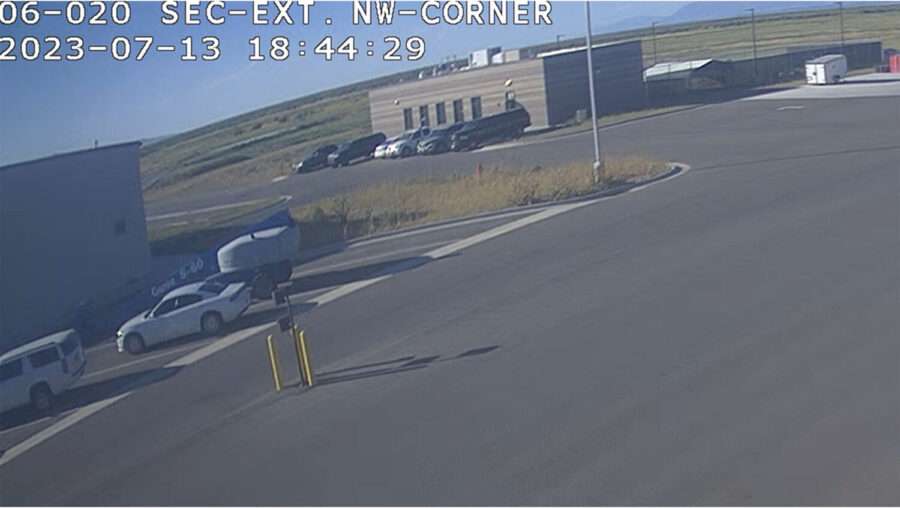Estimated read time: 4-5 minutes
SALT LAKE CITY — In the summer of 2023, Loki, a Department of Corrections K-9, died inside a hot car. A heat alert system, designed to prevent such deaths, had been installed inside the vehicle. But it was not in use that day.
That discovery led KSL Investigators to dig deeper, asking how widely these safety measures are implemented across Utah law enforcement agencies and what training, testing and documentation they require to ensure the system is working.
Security footage from July 13, 2023, shows when Loki was discovered still in the vehicle, not the kennels inside the Utah State Correctional Facility. The timestamp shows it was just before 7 p.m. The dog had been in the vehicle for 3 1/2 hours, while outside temperatures soared to 97 degrees.

Public records show the department purchased one heat alert system in 2020. But the department said it was not installed until three years later.
That system was inside the vehicle where Loki died.
The district attorney's office declined to press charges in Loki's death, saying its investigation found the department bore partial responsibility due to a failure to train employees on how to use the heat alert system.

UDC's policy changes and accountability
Records obtained by KSL Investigates revealed that on the day Loki died, the system was turned off.
"We kind of both have to take accountability for that as an organization and a K-9 unit," said Mike Schoenfeld, the law enforcement bureau chief for the Department of Corrections.
Schoenfeld was hired after Loki's death. He said he reviewed policies around the state as he worked to update his department's protocols for heat alert systems.
The proposed changes include requiring annual training, daily testing of the technology, and documentation of those tests.
His department has now purchased more heat alert systems. Within the next few months, they plan to outfit all 14 of its K-9 vehicles with the system at a cost of nearly $1 million.
"It's not cheap to outfit those, but it's a great investment," Schoenfeld said.

Agent Roscoe Dickson and his partner Max, a 3-year-old Malinois Shepherd Mix, have spent the last year working together for the Department of Corrections.
"I don't know how to explain it, but the bond I have with him is like none other," Dickson said of Max.
They gave KSL a demonstration of the heat alert system.
Dickson said it is set to trigger if the internal temperature of a vehicle goes above 87 degrees. It sends an alert to his pager, rolls down windows and turns on a fan.
He tests the system every day — to protect his partner.
"Not only is this something that should be done, but having it documented helps protect us as well," Dickson said.
How UDC's policies compare to other agencies
The KSL Investigators reached out to 17 of the state's largest law enforcement agencies to ask whether they use similar systems and whether they require training, testing and documentation.
All agencies except Sandy Police responded.
The other 16 all reported having a heat alert system in place: Davis County Sheriff's Office, Department of Natural Resources Law Enforcement, Draper Police Department, Ogden Police Department, Orem Police Department, Provo Police Department, Utah County Sheriff's Office, Utah Highway Patrol, Unified Police Department, St. George Police Department, Salt Lake City Police Department, South Jordan Police Department, Weber County Sheriff's Office, Washington County Sheriff's Office, West Jordan Police Department, and West Valley City Police Department.

However, not all required regular testing.
Eleven agencies said they do require testing. Draper did not provide an answer regarding testing policies. Davis County, South Jordan, and Weber County said they do not require regular testing. Orem said it did not know if testing was required.
"We currently do not have a policy requiring our handlers to test their systems, but after reading your question this will be changed immediately as it will provide an extra safety measure to keep our dogs safe," Weber County Lt. Colby Ryan wrote in response to our questions.
The frequency of testing varies between the departments, ranging from daily to only a few times a year.
Fifteen agencies said they do not require documentation of their tests. Salt Lake City would not answer that question.
The Department of Natural Resources told us it now plans to update its policy to require documentation of system tests.








